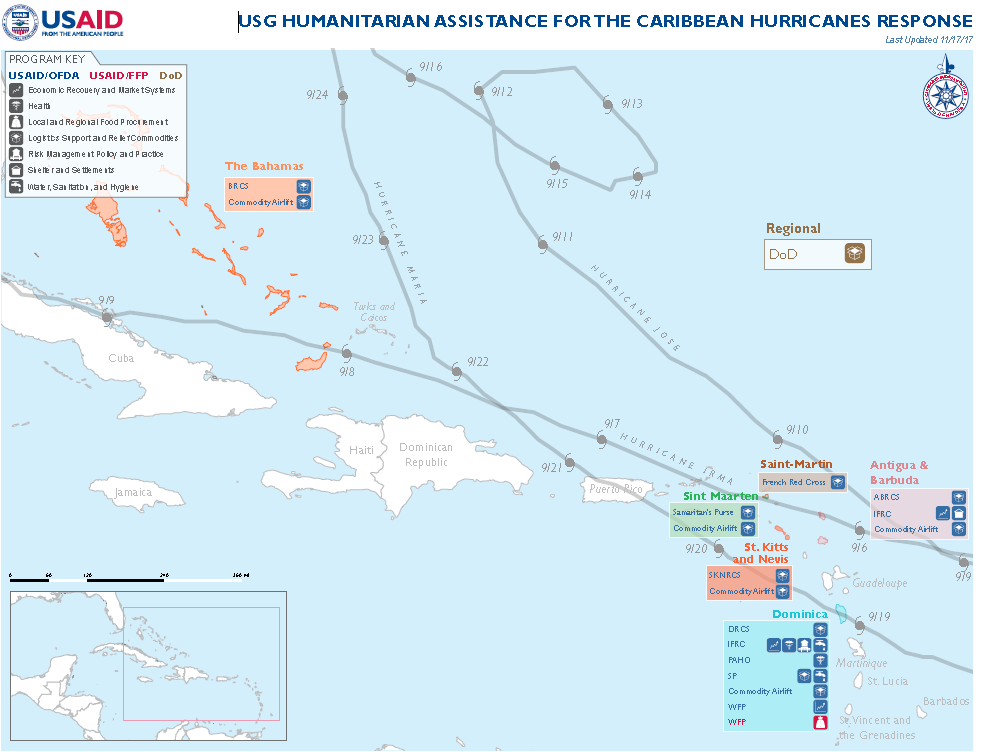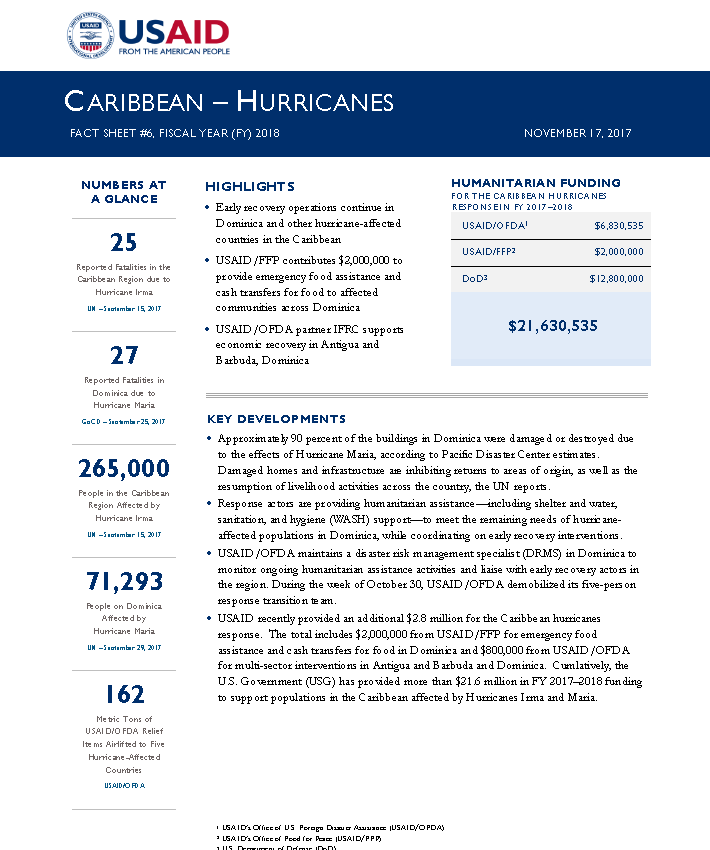Speeches Shim
November 17, 2017
Highlights
- Early recovery operations continue in Dominica and other hurricane-affected countries in the Caribbean
- USAID/FFP contributes $2,000,000 to provide emergency food assistance and cash transfers for food to affected communities across Dominica
- USAID/OFDA partner IFRC supports economic recovery in Antigua and Barbuda, Dominica
Key Developments
Caribbean Hurricanes - Map #6 FY18 ![]() (pdf - 287k)
(pdf - 287k)
Numbers At A Glance
25
27
265,000
71,293
185
Humanitarian Funding
For the Caribbean Hurricanes Response in FY 2017
| USAID/OFDA | $6,830,535 |
| USAID/FFP | $2,000,000 |
| DoD | $12,800,000 |
| Total | $21,630,535 |
Caribbean Hurricanes - Fact Sheet #6 FY18 ![]() (pdf - 146k)
(pdf - 146k)
Approximately 90 percent of the buildings in Dominica were damaged or destroyed due to the effects of Hurricane Maria, according to Pacific Disaster Center estimates. Damaged homes and infrastructure are inhibiting returns to areas of origin, as well as the resumption of livelihood activities across the country, the UN reports.
Response actors are providing humanitarian assistance—including shelter and water, sanitation, and hygiene (WASH) support—to meet the remaining needs of hurricane-affected populations in Dominica, while coordinating on early recovery interventions.
USAID/OFDA maintains a disaster risk management specialist (DRMS) in Dominica to monitor ongoing humanitarian assistance activities and liaise with early recovery actors in the region. During the week of October 30, USAID/OFDA demobilized its five-person response transition team.
USAID recently provided an additional $2.8 million for the Caribbean hurricanes response. The total includes $2,000,000 from USAID/FFP for emergency food assistance and cash transfers for food in Dominica and $800,000 from USAID/OFDA for multi-sector interventions in Antigua and Barbuda and Dominica. Cumlatively, the U.S. Government (USG) has provided more than $21.6 million in FY 2017–2018 funding to support populations in the Caribbean affected by Hurricanes Irma and Maria.
HUMANITARIAN COORDINATION AND LOGISTICS SUPPORT
USAID partner the UN World Food Program (WFP) had coordinated the delivery of more than 570 metric tons (MT) of humanitarian assistance—including emergency food assistance and other relief commodities—to affected populations in Dominica as of November 8. In coordination with the Government of the Commonwealth of Dominica (GoCD), WFP had provided 800 square meters of storage capacity for response actors as of October 29, the UN reports.
Damaged telecommunication infrastructure continues to impede ongoing humanitarian assessments and the provision of assistance to affected populations. The GoCD and local media also report difficulties communicating information on relief and recovery efforts to affected communities across Dominica.
SHELTER AND SETTLEMENTS
More than 740 people were sheltering in 45 collective centers across Dominica as of November 2—a 60 percent decrease from the nearly 1,900 individuals identified as of October 15, the International Organization for Migration reports. The proportion of vulnerable people residing in collective shelters increased from 32 percent to 60 percent between mid-October and early November, indicating that while people are leaving collective centers, vulnerable internally displaced persons (IDPs) remain. A significant number of IDPs continued to shelter with relatives or host families as of November 2, however, the precise figure remains unknown, the UN reports.
Hurricane Maria damaged or destroyed nearly 23,500 houses in Dominica, representing nearly 90 percent of the country’s houses, the UN reports. In response to the continued need for shelter materials, labor support, and shelter repair instruction, USAID/OFDA partner the International Federation of Red Cross and Red Crescent Societies (IFRC) plans to provide plastic sheeting and other relief commodities to 5,000 vulnerable households and building materials for roof repair to 2,500 households in Dominica. In addition, USAID/OFDA recently coordinated the delivery of 380 rolls of plastic sheeting—valued at nearly $139,000—to support the shelter needs of hurricane-affected households in Dominica.
In Barbuda, Hurricane Irma damaged or destroyed approximately 80 percent of houses. USAID/OFDA is supporting IFRC in Antigua and Barbuda to provide cash transfers to support rent payments for vulnerable populations, prioritizing IDPs with severly damaged homes
HEALTH AND WASH
Access to health services in Dominica continues to improve, with 43 of Dominica’s 49 health facilities functioning as of November 9, according to the UN. However, 12 of the 43 facilities were operating from temporary sites or offering reduced services and limited hours, and most facilities remained reliant on generators for electricity. The GoCD Ministry of Health reports that additional health care workers, including primary care doctors, nurses, and mental health specialists, are needed. In response to increased health needs following the hurricane, USAID/OFDA partner IFRC is providing psychosocial support to approximately 3,000 affected individuals in Dominica.
Through rapid repairs of water supply networks, the Dominica Water and Sewerage Company (DOWASCO) had established access to safe drinking water for more than 49,400 people, representing approximately 70 percent of Dominica’s population, as of November 9, the UN reports. Long-term repairs of severely damaged water infrastructure remain ongoing.
Water trucking by DOWASCO, the UN Children’s Fund (UNICEF), and USAID/OFDA partner Samaritan’s Purse (SP) continues to provide safe drinking water to more than 1,600 people per day in areas where water supply networks remain non-functional, according to the UN. In addition, as of November 9, the UN reported that seven mobile water treatment plants operated by DOWASCO, the Dominican Red Cross Society (DRCS), and SP were operational across the country.
FOOD SECURITY AND LIVELIHOODS
While markets are recovering, vulnerable populations in Dominica continue to require in-kind food assistance, according to a late October rapid market assessment by USAID/FFP partner WFP. In coordination with the GoCD, WFP and other relief agencies continue to monitor market recovery, and plan to transition from in-kind emergency food assistance to cash-based interventions in the coming weeks.
Damaged infrastructure across Dominica continues to hinder household access to and availability of food. The WFP assessment found widespread loss of productive assets and livelihood opportunities, as well as the disruption of the food supply chain to local markets. The continued lack of electricity and cell phone service in many communities continues to impede household recovery from the economic impacts of Hurricane Maria.
In coordination with the UN Food and Agriculture Organization, SP, WFP, and other humanitarian actors, the GoCD Ministry of Agriculture and Fisheries continues to lead agricultural recovery efforts in Dominica, including through the distribution of vegetable seeds and electrical generators; livestock production rehabilitation programs; and debris clearance.
USAID/FFP recently provided $500,000 to WFP to support the regional procurement of nearly 380 MT of emergency food assistance, sufficient to supply approximately 30,000 people in Dominica—more than 40 percent of the country’s population—with emergency food rations. This one-time, in-kind ration, distributed in collaboration with the GoCD, aims to relieve pressure on the country's private sector and allow additional time for the re-establishment of food supply chains and the re-stocking of food inventories. As of early November, WFP had dispatched the emergency food assistance to locations throughout the country, while distribution by local authorities remained ongoing.
USAID/FFP provided an additional $1.5 million to WFP to support the provision of cash transfers for food to approximately 25,000 vulnerable individuals across Dominica for an initial period of three months. The program, conducted in coordination with the GoCD, will utilize the country’s existing social protection system to assist hurricane-affected households to access sufficient food commodities and simultaneously support market recovery across the island.
From September to late October, USAID/OFDA staff in Dominica assisted USAID/FFP in monitoring the food security situation and the implementation of emergency food assistance programs in the country. USAID/OFDA staff also participated in the WFP-led food security assessment.
In Antigua and Barbuda, USAID/OFDA partner IFRC plans to provide unconditional cash transfers to the most vulnerable households in order to meet acute needs, while promoting the restoration of livelihoods by providing financial support and skills training to displaced Barbudan households temporarily residing in Antigua, among other activities.
OTHER HUMANITARIAN ASSISTANCE
The Dominica Flash Appeal, released by the UN and the GoCD on September 29, requests $31.1 million to support relief and early recovery activities through December 2017. As of November 9, international donors had provided approximately $11.8 million in funding towards the Flash Appeal, representing nearly 38 percent of the request, according to the UN Office for the Coordination of Humanitarian Affairs (OCHA).
CONTEXT
During successive weeks in September, hurricanes Irma, Jose, and Maria tracked through the Caribbean. The storms, particularly Irma and Maria, brought destructive winds, heavy rainfall, and dangerous storm surge to affected islands, leading to at least 52 fatalities and causing significant infrastructure damage across the region.
On September 6, U.S. Chargé d’Affaires, a.i., Lisa A. Johnson issued a disaster declaration in response to the anticipated effects of Hurricane Irma in The Bahamas, and on September 7, U.S. Ambassador to Barbados and the Eastern Caribbean Linda S. Taglialatela issued a disaster declaration in response to Hurricane Irma and the anticipated effects of Hurricane Jose in Antigua and Barbuda. In response, USAID/OFDA contributed an initial $100,000 each to the Bahamas Red Cross Society (BRCS) and the Antigua and Barbuda Red Cross Society (ABRCS).
On September 7, USAID activated a regional Disaster Assistance Response Team (DART) and stood up a Washington, D.C.-based Response Management Team to coordinate the USG’s response to the hurricanes.
On September 9, U.S. Embassy in Paris Chargé d’Affaires D. Brent Hardt issued a disaster declaration for French Saint-Martin, and on September 10, U.S. Embassy in The Hague Chargé d’Affaires Shawn Crowley declared a disaster for Sint Maarten due to the effects of Hurricane Irma and anticipated effects of Hurricane Jose. In response, USAID/OFDA contributed an initial $100,000 each for activities in Saint-Martin and Sint Maarten.
Following the passage of Hurricane Maria, Ambassador Taglialatela issued disaster declarations for Dominica and Saint Kitts and Nevis on September 19 and 22, respectively. In response, USAID/OFDA provided an initial $100,000 to Dominica and $50,000 to Saint Kitts and Nevis for immediate humanitarian relief efforts.
On October 2, Ambassador Taglialatela renewed the disaster declarations in Antigua and Barbuda and Dominica for FY 2018 due to continued humanitarian needs caused by hurricanes Irma and Maria.
On October 9, the DART demobilized, initiating a shift to early recovery activities. A Dominica-based USAID/OFDA DRMS continues to monitor humanitarian assistance activities and liaise with GoCD officials and humanitarian response organization representatives in Dominica in coordination with USAID/OFDA staff in San José, Costa Rica, and Washington, D.C.
PUBLIC DONATION INFORMATION
The most effective way people can assist relief efforts is by making cash contributions to humanitarian organizations that are conducting relief operations. A list of humanitarian organizations that are accepting cash donations for disaster responses around the world can be found at www.interaction.org.
USAID encourages cash donations because they allow aid professionals to procure the exact items needed (often in the affected region); reduce the burden on scarce resources (such as transportation routes, staff time, and warehouse space); can be transferred very quickly and without transportation costs; support the economy of the disaster-stricken region; and ensure culturally, dietary, and environmentally appropriate assistance.
More information can be found at: USAID Center for International Disaster Information: www.cidi.org or +1.202.661.7710. Information on relief activities of the humanitarian community can be found at www.reliefweb.int.



Comment
Make a general inquiry or suggest an improvement.